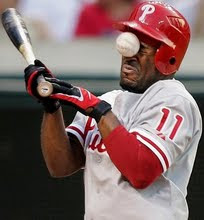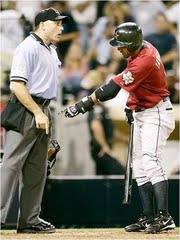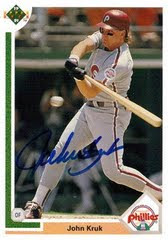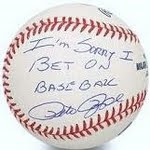Today, I'm going to look at five pitchers who are primed to increase in value this season and five guys who you can expect some serious regression from.
FIVE UP
1. Javier Vazquez
A combination of his lack of success in the AL (minus 2007) in recent years matched against his great peripherals make him unfairly undervalued. Despite posting a FIP of 3.86 or lower each of the past 3 seasons, the absolutely TERRIBLE defense of the Chicago White Sox helped to inflate Javvy's ERA to 4.84, 3.73 and 4.67 over that time frame. Last year, Vazquez struck out 8.64 guys per nine, walked 2.64 per nine and gave up a little over a home run per game (1.08 HR/9), good for a very solid 3.74 FIP. Vazquez's 68.3 LOB% also contributed heavily to an inflated ERA last year. In short, Vazquez's move away from the HR friendly Cell, defensive challenged White Sox and stronger hitting AL to the defensively strong Braves and pitcher-who-bats NL should only make him a top 10 guy in 2009.
2. Jonathan Sanchez
Sanchez is a guy who gets a bad rep due to high ERA/FIP splits and bad luck. Jonathan Sanchez may have a below average defense behind him this year, but his 3.85/5.01 FIP/ERA split in 2008 calls for some extreme regression. In 250 big league innings, Sanchez has struck out 252 guys. Fangraph notes that "batters swung and missed at 10.9% of Sanchez’s pitches, the 9th highest total in baseball." This, combined with a 67.5 LOB% in 2008 tell me that Sanchez is bound to improve.
3. Josh Beckett
After two consecutive season of 200+ IP, the injury bug again bit Beckett, limiting him to a serviceable 27 starts, 175 IP. His ERA was 4.03, but the FIP was a sparkling 3.24. Beckett's K rate has been increasing since 2006, while his BB rate has declined over that same period. Boston had a top 5 defensive team last year and Beckett had an average 71.3 LOB%, so what was the problem? As his -0.92 clutch rating (a fangraphs metric that compares a player's performance in high leverage situations to performance in low leverage situations) highlights, Josh Beckett allowed a majority of his walks and extra-base hits in situations when runners were in scoring position. Despite Beckett's tendency to be slightly unclutchy on the Red Sox, there's absolutely no reason to think that this extreme unclutchiness will continue in 2009. Simply put, all signs point to a return to great success for Josh Beckett next year.
4. Derek Lowe
This extreme groundballer is second only to Brandon Webb when it came to burning worms last year. Despite his four years of success in Dodgers Stadium, there is arguably room for improvement (despite Lowe's increasing age). Groundballers tend to be more reliant on the defense of the infield behind them to keep their numbers good. One would assume, using FIP as the breakever point, that a pitcher on a team with a good defensive infield would outperform their FIP, while one a defensively challenged team would underperform their FIP. According to fangraphs data, the Dodgers infield last year combined to be -32.3 fielding runs below average, while the Braves infield was worth a positive 2.5 fielding runs above average (Kelly Johnson's limited range kind of took down the team's total defensive value by being -9.0 Fielding Runs below average last year, but was similtaneously slightly above average when it came to not making errors). So while Derek Lowe negligibly underperformed his FIP in each of his four years on the Dodgers except 2005 (his FIP/ERA splits between 2005 and 2008 were 4.16/3.61, 3.68/3.63, 3.97/3.88 and 3.26/3.24), you have to expect a favorably larger FIP/ERA split going forward for the 35 year old ex-closer whose lack of K's is subsidized by superior control (2.60+ K/BB as a starter) and a lack of home runs (.65 HR/9 as a starter). If nothing more, expect Derek Lowe to continue to post an ERA around/below 3.6 and a solid WHIP in the 1.2 range over 200ish innings.
5. Andrew Miller
Going back to the "quality pitchers who get a bad rap due to poor FIP/ERA splits" theme, Andrew Miller was the most unfortunate victim of bad luck amongst all major leaguers last season. Despite increasing his K rate and decreasing both his walk and home run rates in each of the past three seasons, Andrew Miller's ERA has risen each year. His FIP/ERA splits since 2006 are 5.47/6.10, 5.27/5.63 and 4.00/5.87. A lot of this is due to the fact that both the Marlins and Tigers rank amongst the league's worst defensive teams, but how much of Andrew Miller's league leading +1.87 F-E (FIP-ERA) ratio should persist next year? Miller has a great arm that is primed for a breakout season if he finds shelter on a friendlier team. Even on the Marlins, we should expect a sharp decline in ERA from Andrew Miller next season, hopefully to a fantasy relevant range.
FIVE DOWN
1. Johan Santana
Each of the past two seasons have seen a sharp decline in Santana's once unquestionably dominate peripherals. After averageing a FIP of 3.03 between 2002 and 2006, Santana has seen his FIP rise to 3.81 and 3.51 over the past two seasons, as his strike out rate has fallen and walk rate risen. Santana's career best 2.53 ERA was largely the by-product of ridiculously lucky 82.6 LOB% (over 10% above league average) and a defensively awesome defense (sixth best in the league at converting balls in play into outs). Santana, who struck out less than 9 guys per nine (7.91 per nine to be exact) for the first time since 2001, is bound to bounce back some in his strike out rate from last season (the projection systems on fangraphs see it landing somewhere in the upper 8's per nine range), but Santana's declining numbers indicate that he may be on the decline and is certainly no longer worth an automatic first round pick (and certainly not a pick above Tim Lincecum, who despite his injury potential, posted an ERA/FIP split of exactly zero). Johan Santana has achieved almost all that we can expect from him and thus presents little, if any, upside (and a lot of downside) at pick #16. Santana's just a brand name, at the point, and I strongly suggest you avoid paying that premium.
2. Gavin Floyd
One of the many reasons that the outlook for the 2009 White Sox is so grim is that much of the team's success derived from a great pitching core that outperformed its peripherals. Gavin Floyd posted a quality 3.87 ERA, despite a 4.77 FIP that resulted in a mediocre 6.32 K/9 rate and hellish 1.31 HR/9 rate. As a flyball pitcher in the home run friendly US Cellular Field, the projection systems on fangraphs sees Floyd's HR/9 rate increasing to the 1.4 or even 1.5 per nine range, while projecting a 10% decline in his control (from 2.07 K/BB to the 1.8 K/BB range). Even if Gavin Floyd didn't regress to the 5.00 FIP range next year, you'd have to expect a sharp rise in ERA for the sophomore hurler who was just handed a four-year contract.
3. Armando Galaragga
Like Gavin Floyd, Armando Galaragga is a flyball pitcher who got incredibly lucky last year. His ridiculously low .250 BABIP helped mask his poor 4.88 FIP with a quality 3.73 ERA. Tigers fans who expect a repeat performance from the man who gave up 1.4 HR/9 and struck out a mere 6.53 per nine are going to be in for some severe disappointment. Even if Galaragga maintains his 2.07 K/BB and decreased his HR/9 rate, you've still got to worry about the effects of the very below average defense of the Tigers on Galaragga's numbers. To say the least, the outlook for Armando Galaragga is bleak.
4. Daisuke Matsuzaka
Dice-K still struck out a lot of guys last year, but his numbers indicate some impending regression. In 2008, Dice-K upped his walk rate by 1.5 guys per nine and decreased his K rate by from 8.84 K/8 to 8.27 K/9. At the same time, Dice-K almost halved his HR/9, while neither increasing his GB rate nor decreasing his FB rate -- meaning the downturn was probably a fluke rather than an increase in skill. Furthermore, Dice-K's 18% line drive rate says that his .267 BABIP of 2008 is bound to regress somewhere towards the .290-.300 range. Dice-K's FIP/ERA split last season was 4.03/2.90, and while Boston had a great defense last season (fifth in defensive efficiency), it wasn't and isn't good enough to reasonably sustain a 1.03 F-E. In 2009, I fully expect Dice-K's ERA to be closer to his 2007 numbers than those of last season -- those free passes are going to come back to bite him big time.
5. Joe Saunders
Despite a 91 MPH fastball and above average control (2.41 BB/9), there is much to not like about Saunders (such as his anemic 4.68 K/9 rate and ridiculously low .267 BABIP). Last year, despite posting an average 4.36 FIP and barely 100 Ks to go with 200 innings of work, Joe Saunders put up ace-quality numbers with a 3.41 ERA and 17 Wins. Unfortunately for Halos fans and Saunders, his above average control and average home run rates can't overcome his 30% below average strikeout rate. Saunders is no Greg Maddux.
TWO GUYS WHO COULD GO EITHER WAY
1. Justin Duchscherer
I love me some "Doosher", but his 2009 season could go either way. On one hand, Duchscherer is an injury prone 31 year old with a 3.69/2.54 FIP/ERA split. On the other hand, a 3.69 FIP is nothing to scoff at and the Oakland A's were one of the game's top defensive teams last year (fourth in defensive efficiency). Despite a below average K rate, Doosher's stellar control (2.16 BB/9) and lack of longballs (.70 HR/9) make him a candidate for continued, although comparatively diminished, success. I would expect a mid 3 ERA from Duchscherer to go along with a limited innings load in 2009 (he's starting the first six weeks of the season on the DL).
2. Andy Pettite
Despite posting an ERA north of 4.00 in each of the past two seasons, Andy Pettite's FIP has been below 3.90 (3.71 FIP in 2008) in each of those seasons. Pettite's inflated ERA has largely been due to the extremely poor defensive abilities of guys like Derek Jeter Jason Giambi and Bobby Abreu in the field. With Abreu, Giambi and even Matsui out of the field and the addition of Mark Teixeira (+10.7 fielding runs above average last year), you have to expect some improvement in the ability of the Yankee's defense. On the other hand, both Johnny Damon and Derek Jeter's defense are on a rapid decline, while A-Rod hip may hinder his range when he returns. In short, whether or not the Yankee's defense as a whole will significantly improve this year is questionable and Pettite's FIP/ERA splits seem dependant on where the defensive coin toss lands. There's no reason to expect a poor (above 4) FIP or significant downturn in IP from Pettite this year, however.
skip to main |
skip to sidebar

That pitch accounted for 15% of Jimmy Rollin's OBP for 2006

Is my .320 batting average giving you a boner?

That Darren Erstad was a punter in college??

John Kruk struck out in this AB

Statistically speaking, sacrifice bunts are counter-productive

Best signature ever

Written by none other than Joe Morgan
Buy Tickets!
Gophers Fans, Buy Gophers Tickets including Gopher Basketball Tickets today. Check out Williams Arena Tickets and buy Minnesota Gophers Basketball Tickets today.
The 25 Greatest Movies Of The Past 25 Years
GOI Fantasy Sports Analysis
Contributors
- Sexy Rexy
- The 'Bright' One
- David "MVP" Eckstein
- Cubsfan4evr
Board Bets
Search GOI, Fangraphs, And The Hardball Times For Content
Local Blogs We're Reading
National Blogs We're Reading
Finding Stats
Faceball

That pitch accounted for 15% of Jimmy Rollin's OBP for 2006
Ump Bump

Is my .320 batting average giving you a boner?
Did You Know...

That Darren Erstad was a punter in college??
Little Known Fact

John Kruk struck out in this AB
The Great Runs Expectancy Chart

Statistically speaking, sacrifice bunts are counter-productive
Pete Rose Baseball

Best signature ever
The Most Ironic Book Ever Written

Written by none other than Joe Morgan
Blog Archive
-
▼
2009
(1258)
-
▼
March
(70)
- More Stupid Comments
- Five Up, Five Down
- Fantasyland, Version 2009, Part II
- Moose On The Loose
- Cory Provus No Longer With Us
- What Is Fantasyland?
- Fantasyland, Version 2009
- David "MVP" Eckstein's Drafting Strategy for Pitchers
- Sexy Rexy's Drafting Strategy
- Fantasy Draft Results
- The lesser of two evils
- Carlos Pena Hits HRs, Signs Tacos
- Fangraphs: How Many Pitches Does It Take?
- Baseball's Top Defenders, 2008
- Arod and Ozzie
- Miller to Morgan to Phillips. Triple play!
- Sexy Rexy’s Drafting Tips
- Alexei=Next Ozzie?
- Experts in College Basketball
- Porn>Sports
- What DID Happen To Andruw Jones?
- Jim Calhoun is Sick. Oh No! Stop the Presses!
- Just how bad is Dunn's defense
- Adam Dunn sucks at first base too
- In Defense Of Steroids, Part II
- The Blackhawks are chocking, hard
- 2 words to describe 2009 Bears: Illegal Formation
- ESPN Commercial
- The downside of being white
- Saves
- WBC Injury+David Letterman
- I Hate Jerry Angelo SO MUCH!
- Mark Prior's $1 Million Scam
- Sigh
- David Eckstein's Projected Stat Line
- Hubert Davis Hates the Big Ten, No Surprise There
- Why I Hate College Basketball, Part II: Conference...
- Horrible Trades, Wiped Out Farm Systems
- Is Edinson Volquez For Real?
- Japanese Imperialism
- Is John Danks For Real?
- The Great Runs Expectancy Chart
- Fantasy Baseball Resources, take 2
- Quick WBC Notes
- Applying Statistics to Actors
- Matthew Berry Is Consistent
- 30 Teams In 30 Days Is Dumb
- Chicago Cubs roster preview
- The Detroit Tigers
- Derek Jeter's half whiteness is better than your f...
- The AL East
- Cleveland Indians
- The Minnesota Twins
- The Chicago White Sox
- The Toronto Blue Jays
- The New York Yankees
- In Defense Of Steroids
- Eastbound And Down
- The Boston Red Sox
- 30 Teams In 30 Days: A Baseball Preview
- The Cubs in the World Baseball Classic
- Dusty’s Reds changing approach
- The Baltimore Orioles
- Why is Hamilton playing Center?
- Wood Bothered by back Stiffness
- Hoffman Classy guy
- Chicago Cubs non-roster Invitees
- The Matt Cassel Trade
- The Tampa Bay Rays
- Free Agency: Bears Addition
-
▼
March
(70)
0 comments:
Post a Comment